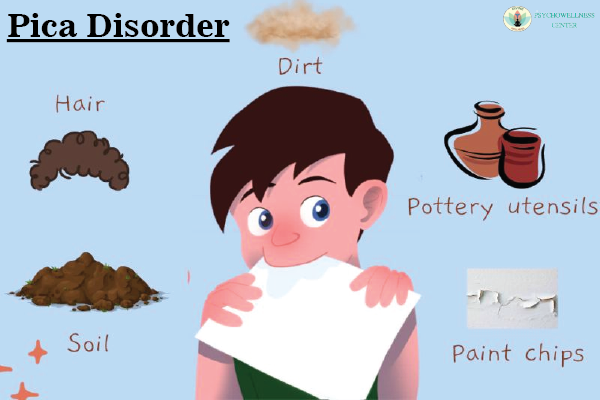Pica disorder is a relatively rare and often misunderstood condition that is characterized by the persistent consumption of non-food items. Pica can affect people of all ages, but it is most commonly diagnosed in children and individuals with intellectual disabilities.
What is Pica Disorder?
The Diagnostic and Statistical Manual of Mental Disorders (DSM-5) defines pica disorder as the persistent eating of non-food items for a period of at least one month, that is not a part of culturally sanctioned practice, and that is not a result of a lack of available food or of culturally approved practice. Pica can involve the ingestion of a wide range of non-food items, including dirt, paint, clay, ice, paper, hair, and feces.
Pica is not a single disorder, but rather a symptom that can be caused by a variety of underlying conditions, including iron-deficiency anemia, malnutrition, and gastrointestinal disorders. Pica can also be associated with mental health conditions such as obsessive-compulsive disorder, schizophrenia, and developmental disorders such as autism spectrum disorder.
Symptoms of Pica Disorder
The symptoms of pica disorder can vary depending on the age of the person affected and the nature of the non-food item consumed. Symptoms may include:
-
Persistent ingestion of non-food items
-
Stomach pain or discomfort
-
Dental problems
-
Bowel obstruction
-
Malnutrition or anemia
-
Behavioral problems
-
Complications from toxic substances
-
Fatigue or weakness
The symptoms of pica can be severe, and in some cases, can lead to serious health problems or even death.
Psychological Mechanisms Behind Pica
-
Psychodynamic Perspective:
-
From a psychodynamic perspective, pica may be understood as a manifestation of underlying emotional conflicts or unmet needs. The consumption of non-food items might serve as a coping mechanism to deal with internal distress or unresolved issues from early childhood experiences. For example, the act of eating non-food substances could be linked to oral fixation or a need for comfort.
-
-
Behavioral Perspective:
-
According to behavioral theories, pica can be seen as a learned behavior that is reinforced over time. For instance, if a child receives attention or a specific reaction from caregivers after engaging in pica, this behavior might be reinforced and repeated. Behavioral interventions often focus on modifying these patterns through positive reinforcement and other behavioral techniques.
-
-
Cognitive Perspective:
-
Cognitive theories suggest that individuals with pica might have distorted thinking patterns or cognitive deficits that lead them to consume non-food items. For instance, they might believe that eating certain substances can provide nutritional benefits or alleviate discomfort. Cognitive-behavioral therapy (CBT) can be useful in addressing these maladaptive thought patterns and developing healthier coping strategies.
-
Causes of Pica Disorder
The causes of pica disorder are not fully understood, but there are several factors that are believed to contribute to the condition. Some possible causes of pica disorder include:
-
Nutritional deficiencies: Pica is often associated with an underlying nutritional deficiency, such as iron-deficiency anemia. The body may crave non-food items as a result of a lack of essential nutrients.
-
Mental health conditions: Pica can be associated with certain mental health conditions, such as obsessive-compulsive disorder or schizophrenia. The person may use pica as a coping mechanism for their worry or discomfort.
-
Developmental disorders: Individuals with developmental disorders such as autism spectrum disorder may engage in pica as a form of self-stimulation or as a result of sensory-seeking behaviors.
-
Cultural practices: In some cultures, the consumption of certain non-food items is considered normal or even desirable. In these cases, pica may not be considered a disorder.
Diagnosis and Treatment of Pica Disorder
Pica disorder can be challenging to diagnose, as there are many potential underlying causes of the condition. A thorough medical evaluation is typically required to determine the cause of pica and to rule out other potential health problems. A diagnosis of pica disorder is typically made if the person has been ingesting non-food items persistently for at least one month and if the behavior is not part of a culturally sanctioned practice.
The treatment of pica disorder depends on the underlying cause of the condition. If pica is associated with an underlying nutritional deficiency, the person may be given supplements or dietary consultation via Online counseling to address the deficiency. If pica is related to a mental health condition, such as obsessive-compulsive disorder, medication and therapy from the Best psychologist in India or Counseling psychologist may be used to manage the symptoms of the condition.
In cases where pica is associated with a developmental disorder, such as autism spectrum disorder, behavioral therapy and sensory integration techniques may be used to help manage the behavior. In some cases, medication may be prescribed by the Best psychiatrist in India to help manage associated symptoms, such as anxiety or hyperactivity.
Conclusion
Pica disorder is a complex condition that can have serious health consequences if left untreated. The condition is often associated with underlying nutritional deficiencies such as iron deficiency, calcium deficiency etc.
To schedule an appointment at the Psychowellness Centre, offering top-notch mental health therapy by licensed psychologists, is a wise choice. With locations across Delhi NCR, including Janakpuri, Dwarka, and Faridabad, our center offers extensive assistance for diverse mental health issues.
Contribution: Dr (Prof) R K Suri, Clinical Psychologist, life coach & mentor TalktoAngel & Ms Aditi Bhardwaj, Psychologist.

